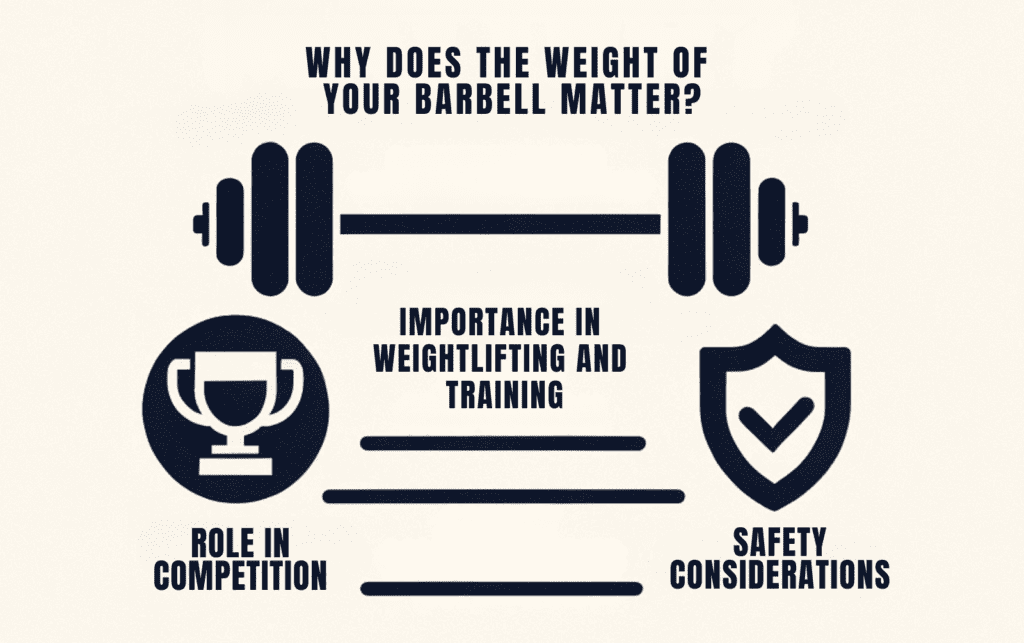If you’re here, you want to know how much that barbell you’re lifting actually weighs.
Well, let’s cut to the chase—your standard Olympic barbell weighs 45 pounds or 20 kilograms. But hey, that’s just the tip of the iceberg.
There are various types of barbells, each with its own weight and purpose.
Stick around, and I’ll break it all down for you.
On This Page
Key Takeaways
| Question | Answer |
| How much does an Olympic barbell weigh? | 45 pounds (20kg) |
| Why does the weight of the barbell matter? | It’s crucial for effective training, competition, and safety. |
| What factors affect a barbell’s weight? | Material, length, diameter, knurling, and collars. |
| Are there specialized barbells for different exercises? | Yes, different barbells are designed for specific exercises and muscle groups. |
| How can I verify the weight of my barbell? | Use a scale, check manufacturer’s specifications, or seek professional verification. |
Why Does the Weight Of Your Barbell Matter?

Ever wondered why professional athletes and trainers always know the weight of their barbells down to the last gram? It’s not just a numbers game.
The weight of your barbell plays a pivotal role in your training, competition performance, and overall safety. Let’s delve into why it’s so crucial.
Importance in Weightlifting and Training
When it comes to weightlifting and training, knowing the weight of your barbell is more than just a number—it’s a strategy.
It sets the foundation for your entire workout, helping you calculate the load for each exercise.
Role in Competition
In the competitive world of weightlifting, every pound counts.
Knowing the exact weight of your barbell can be the difference between setting a new personal record and missing the podium.
Safety Considerations
Safety first, always. The weight of your barbell isn’t just about lifting more; it’s about lifting smart.
Knowing the weight helps you avoid overloading and reduces the risk of injury.
Types of Barbells & How Much They Weigh
Have you ever found yourself staring at the array of barbells at the gym, wondering which one to pick? You’re not alone.
The variety can be overwhelming, but each type of barbell serves a unique purpose and comes with its own weight specifications.
Let’s break it down, bar by bar.
| Type of Barbell | Weight/Range (Lbs) | Average (Lbs) | Weight/Range (Kg) | Average (Kg) |
| Standard Barbell | 15-25 | 20 | 6.8-11.3 | 9.1 |
| Olympic Barbell (Men’s) | 44 | 44 | 20 | 20 |
| Olympic Barbell (Women’s) | 33 | 33 | 15 | 15 |
| Trap or Hex Bar | 28-92.4 | 59.8 | 12.7-41.9 | 27.1 |
| EZ Bar | 10-35 | 22.5 | 4.5-15.9 | 10.2 |
| Triceps Bar | 16-25 | 20.5 | 7.3-11.3 | 9.3 |
| Safety Squat Bar | 40-70 | 58.8 | 18.1-31.8 | 26.7 |
| Swiss/Multi-Grip Bar | 27-48 | 40.6 | 12.3-21.8 | 18.4 |
| Smith Machine Bar | 5-45 | 25 | 2.3-20.4 | 11.3 |
| Powerlifting Bar | 44-45 | 44.5 | 20-20.4 | 20.2 |
| Log Bar | 50-134 | 74.2 | 22.7-60.8 | 33.7 |
| Short Bar | 5.5-44 | 25.4 | 2.5-20 | 11.5 |
| Deadlift Bar | 44 | 44 | 20 | 20 |
Standard Barbell

The Standard Barbell is your go-to for basic weightlifting. It’s not as heavy-duty as some other types but gets the job done for beginners and intermediate lifters.
The weight range for a Standard Barbell is between 15-25 lbs, with an average weight of 20 lbs.
In kilograms, that’s a range of 6.8-11.3 kg, with an average of 9.1 kg.
Olympic Barbell

The Olympic Barbell is the gold standard (see what I did there?) for serious weightlifting and is used in competitions.
Men’s bars typically weigh 44 lbs (20 kg), and women’s bars weigh 33 lbs (15 kg). The average weight is around 38.5 lbs or 17.5 kg.
RELATED – Women’s Barbell vs Men’s Barbell – Unveiling the Major Differences
Hex/Trap Bar

The Hex or Trap Bar is a hexagonal-shaped barbell that you stand in the middle of. It’s great for deadlifts and shrugs.
The weight can range from 28 to 92.4 lbs, with an average weight of 59.8 lbs. In kilograms, that’s a range of 12.7-41.9 kg, with an average of 27.1 kg.
| Brand of Hex/Trap Bar | Weight in Lbs | Weight in Kg |
| Rep Fitness Open Trap Bar (Frame + Rotating) | 92.4 | 42 |
| Bells Of Steel Industrial Rackable Hex | 80 | 36 |
| Rep Fitness Open Trap Bar (Frame + Narrow) | 75.6 | 34 |
| Rep Fitness Open Trap Bar (Frame + Standard) | 74.3 | 34 |
| Kabuki Strength Trap Bar HD | 66 | 30 |
| Rep Fitness Open Trap Bar (Frame + Wide) | 71.2 | 32 |
| Rogue TB-2 Trap Bar | 60 | 27 |
| Titan Fitness Rackable Hex Trap V3 | 60 | 27 |
| Valor Fitness Hex Bar | 60 | 27 |
| Eleiko Öppen Bar | 55.12 | 25 |
| Fringe Sport Hex “Trap” Bar | 45 | 20 |
| Cap Barbell Hex Bar | 28 | 13 |
| Average Weight (Excluding Multiple Handlebars) | 59.8 | 27 |
EZ Bar
The EZ Bar is designed for arm exercises like curls and extensions. Its ergonomic design allows for a more natural wrist position.
The weight can range from 10-35 lbs, with an average weight of 22.5 lbs. In kilograms, that’s a range of 4.5-15.9 kg, with an average of 10.2 kg.
Triceps Bar

The Triceps Bar is specifically designed to train the triceps but you can also use it as a hammer curl bar.
It usually weighs between 16-25 lbs (7.3-11.3 kg), with an average weight of 20.5 lbs (9.3 kg).
Safety Squat Bar

The Safety Squat Bar is designed for squats but with added safety features. Weight range: 40-70 lbs (18.1-31.8 kg). Average: 58.8 lbs (26.7 kg).
| Brand | Weight in Lbs | Weight in Kg |
| Rogue SB-1 | 70 | 32 |
| Power Lift | 70 | 32 |
| Rep Fitness | 68 | 31 |
| SS Yoke Bar (EliteFTS) | 65 | 30 |
| Marrs Bar | 65 | 30 |
| Titan Fitness | 61 | 28 |
| Gopher | 60 | 27 |
| Kabuki Transformer Bar | 55 | 25 |
| Bells Of Steel | 47.5 | 22 |
| Mirafit | 46 | 21 |
| Strength Shop Riot | 45 | 21 |
| Power Systems | 40 | 18 |
| Average | 58.8 | 27 |
Swiss/Multi-Grip Bar

The Swiss or Multi-Grip Bar is a versatile piece of equipment that can add variety to your lifting routine.
The variations in weight are often due to differences in material, construction quality, and additional features like extra grips or knurling patterns.
Below are the different weights of some of the most popular brands of bars.
| Brand | Weight in Lbs | Weight in Kg |
| Archon | 30 | 13.64 |
| Fringe Sport | 46 | 20.91 |
| Get RX’d | 47 | 21.37 |
| Rep Fitness | 45 | 20.46 |
| ROGUE MG-1 | 39 | 17.73 |
| ROGUE MG-3 | 43 | 19.55 |
| Synergee | 27 | 12.28 |
| Titan Fitness | 48 | 21.82 |
| Average | 40.6 | 18.5 |
As you can see, Swiss bars can weigh between 27 and 48 lbs or 12.28 and 21.82 kg, with an average weight of 40.6 lbs or 18.5 kg
Luckily, this is a pretty small range, so you can be sure your Multi-Grip bar will be in the same 10-20 lb range.
Smith Machine Bar

The Smith Machine Bar is used in a Smith Machine and usually weighs between 15-25 lbs (6.8-11.3 kg), with an average weight of 20 lbs (9.1 kg).
Powerlifting Bar

The Powerlifting Barbell is designed for powerlifting exercises like squats, deadlifts, and bench press.
They have to weigh 44 lbs (20 kg) or 45 lbs (20.4 kg) to be used in competition so usually manufacturers ensure it’s as close to that as possible.
Multipurpose Bar

The Multipurpose Bar is designed for a variety of exercises and usually weighs 44 lbs (20 kg) for men and 33 lbs (15 kg) for women.
Log Bar

Log Barbells are used in strongman competitions and have a cylindrical shape. The average weight is around 74.2 lbs (33.7 kg).
| Brand and Size of Log Bar | Weight in Lbs | Weight in Kg |
| Rogue 12″ | 134 | 61 |
| Titan 12″ | 84 | 38 |
| Rogue 10″ | 72 | 33 |
| Valor 10″ | 69 | 31 |
| Titan 10″ | 70 | 32 |
| Valor 8″ | 59 | 27 |
| Rogue 8″ | 51 | 23 |
| Titan 8″ | 50 | 23 |
| Average Weight | 74.2 | 34 |
I’ve also included the average weight based on the diameter of the log itself. The thicker it is, the more the base weight of the bar is, naturally.
| Size of Log Bar | Average Weight in Lbs | Average Weight in Kg |
| 8″ | 53.3 | 24 |
| 10″ | 70.3 | 32 |
| 12″ | 109 | 49 |
Short Barbells

Short Barbells are shorter versions of standard barbells and are used for specific exercises. The average weight is around 25.4 lbs (11.5 kg).
| Brand | Weight in Lbs | Weight in Kg |
| Eleiko XF Bar | 44 | 20 |
| GetRXD Shorty Olympic Bar | 33 | 15 |
| Fringe Sport Shorty Barbell | 33 | 15 |
| Titan 60″ Olympic Barbell | 25 | 11 |
| ROGUE C-68S Bar | 25 | 11 |
| Rogue C-70S Bar | 33 | 15 |
| RitFit 4FT Olympic Barbell | 17.5 | 8 |
| RAGE Fitness 6′ Olympic Bar | 16 | 7 |
| Rogue T-2.5 Technique Bar | 5.5 | 2.5 |
| Average | 25.4 | 11.5 |
Deadlift Bar

The Deadlift Barbell is specifically designed for deadlifting and usually weighs 44 lbs (20 kg).
RELATED – What Is A Deadlift Bar?
Factors That Affect Barbell Weight
So you’ve got your eye on a barbell, but wait—why does it weigh what it does? It’s not just a hunk of metal; several factors contribute to a barbell’s weight.
Understanding these can help you make an informed choice, whether you’re setting up a home gym or gearing up for a competition.
From the type of barbell to the material it’s made from, let’s break down what makes your barbell tip the scales.
| Factor | How It Affects Weight |
| Type of Barbell | Different types have different base weights. |
| Length of the Bar | Longer bars usually weigh more. |
| Material | Steel is heavier than aluminum. |
| Diameter of the Bar | A larger diameter often means more weight. |
| Knurling | Minimal impact but can add slight weight. |
| Collars | Can add 0.5-2.5 lbs (0.25-1.14kg) depending on the type. |
What About Weight Clips and Locks?
Sure, they may seem like small accessories, but weight clips and locks can be game-changers in your lifting routine.
Not only do they secure your plates, but they also add to the total weight you’re lifting.
Here’s how they stack up.
| Type of Clip or Lock | LB | KG |
| Spring Clip | 0.5-1 lbs each | 0.25-0.5kg each |
| Lock-Jaw Collar | 0.5-1.1 lbs each | 0.25-0.5kg each |
| Screw Collar | 1.14-2.5 lbs each | 0.5-1.14kg each |
Weight Plate Increments
Weight plates come in all shapes and sizes—literally. Knowing the main increments can help you fine-tune your lifting routine.
Here’s the updated list.
| Type of Weight Plate | LB | KG |
| Standard Plates | 1.25, 2.5, 5, 7.5, 10, 12.5, 20, 25, 35, 45, and 100 lbs | 0.5, 7.5, 1.25, 2.5, 5, 10, 15, 20, and 25kg |
| Olympic Plates | 2.5, 5, 10, 25, 35, 45, and 100 lbs | 1.25, 2.5, 5, 10, 15, 20, and 25kg |
| Bumper Plates | 10, 15, 25, 35, 45, 55 lbs | 5, 10, 15, 20, and 25kg |
| Technique Plates | 5 and 10lb | 2.5 and 5kg |
| Fractional Plates | 0.25, 0.5, 0.75, 1.25 lbs | 0.125, 0.25, 0.5, 0.75, 1, kg |
How to Verify the Weight of Your Olympic Bar
So you’ve got an Olympic bar, but how can you be sure it weighs as much as it claims?
Whether you’re prepping for a competition or just want to keep your home gym legit, here are some ways to verify the weight of your bar.
| Method | How to Do It | Reliability |
| Using a Scale | Place the bar on a calibrated scale. | Highly reliable if the scale is accurate. |
| Manufacturer’s Specifications | Check the product details or manual. | Generally reliable but may vary slightly. |
| Professional Verification | Have it weighed by a certified professional. | Most reliable but may be costly. |
Best Barbell Exercises
So you’ve got your barbell and you’re itching to lift. But what are the best exercises to get you those gains? Let’s break it down.
Barbell Back Squat

The barbell back squat is a staple for building lower body strength. It targets your quads, glutes, and lower back.
Not only does it help you build muscle mass, but it also improves your stability and balance.
Deadlift

The deadlift is a full-body workout that hits your hamstrings, glutes, and your entire posterior chain.
It’s excellent for building strength and power, and it’s one of the most functional exercises you can do.
Bench Press

Ah, the classic bench press. This exercise targets your chest, triceps, and shoulders.
It’s great for building upper body strength and muscle mass. Plus, it’s a key exercise for anyone looking to improve their push strength.
Overhead Press

The overhead press is all about shoulder strength. It targets your shoulders and triceps and helps improve stability in your upper body. It’s a must-add to any strength training routine.
Barbell Row

The barbell row is your go-to for upper back strength. It targets your back and biceps and helps improve your posture.
It’s also a great counterbalance to all the pressing movements in your routine.
Barbell Curl

Last but not least, the barbell curl. This one’s for the guns. It targets your biceps and helps you build arm strength and muscle mass. Because who doesn’t want impressive arms?
Conclusion
You’ve ventured into the world of barbells, from understanding why their weight matters to knowing how to verify it.
I’ve also explored the types of barbells, and the factors that affect their weight, and even dived into some killer exercises to get you started.
Hopefully, this helps you out and I’ll talk to you guys soon.
Until next time,
-Dante